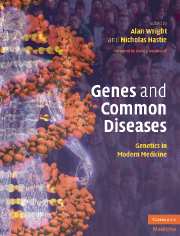Book contents
- Frontmatter
- Contents
- List of Contributors
- Foreword
- Section 1 Introductory Principles
- Section 2 Common Medical Disorders
- 13 Developmental disorders
- 14 Genes, environment and cancer
- 15 The polygenic basis of breast cancer
- 16 TP53: A master gene in normal and tumor suppression
- 17 Genetics of colorectal cancer
- 18 Genetics of autoimmune disease
- 19 Susceptibility to infectious diseases
- 20 Inflammatory bowel diseases
- 21 Genetic anemias
- 22 Genetics of chronic disease: obesity
- 23 Type 2 diabetes mellitus
- 24 Genetics of coronary heart disease
- 25 Genetics of hypertension
- 26 Obstructive pulmonary disease
- 27 Skeletal disorders
- 28 The genetics of common skin diseases
- 29 Molecular genetics of Alzheimer's disease and other adult-onset dementias
- 30 Major psychiatric disorders in adult life
- 31 Speech and language disorders
- 32 Common forms of visual handicap
- 33 Genetic and environmental influences on hearing impairment
- 34 Pharmacogenomics: clinical applications
- Index
- References
20 - Inflammatory bowel diseases
Published online by Cambridge University Press: 17 August 2009
- Frontmatter
- Contents
- List of Contributors
- Foreword
- Section 1 Introductory Principles
- Section 2 Common Medical Disorders
- 13 Developmental disorders
- 14 Genes, environment and cancer
- 15 The polygenic basis of breast cancer
- 16 TP53: A master gene in normal and tumor suppression
- 17 Genetics of colorectal cancer
- 18 Genetics of autoimmune disease
- 19 Susceptibility to infectious diseases
- 20 Inflammatory bowel diseases
- 21 Genetic anemias
- 22 Genetics of chronic disease: obesity
- 23 Type 2 diabetes mellitus
- 24 Genetics of coronary heart disease
- 25 Genetics of hypertension
- 26 Obstructive pulmonary disease
- 27 Skeletal disorders
- 28 The genetics of common skin diseases
- 29 Molecular genetics of Alzheimer's disease and other adult-onset dementias
- 30 Major psychiatric disorders in adult life
- 31 Speech and language disorders
- 32 Common forms of visual handicap
- 33 Genetic and environmental influences on hearing impairment
- 34 Pharmacogenomics: clinical applications
- Index
- References
Summary
Introduction
Inflammatory bowel diseases (IBD) consist of two major disorders: Crohn's disease (CD, OMIM 266600) and ulcerative colitis (UC, OMIM 191390). They are both characterized by a chronic or relapsing inflammation of the digestive tract (for review see Shanahan, 2002; Podolsky, 2002). In UC, the inflammation is limited to the colon with continuous mucosal inflammation already affecting the rectum. On the other hand, CD may affect all the digestive tract from the mouth to the anus with discontinuous lesions. The inflammation is often transmural with potential complications including fistulas, abscesses and strictures. At late stages, granulomas with giant and epithelioid cells are encountered in biopsies or specimens in about half of CD cases.
UC and CD are usually diagnosed in patients presenting with isolated or associated symptoms such as: diarrhea, rectal bleeding, abdominal pain, inflammatory syndromes and malabsorption. Both disorders can be complicated by under-nutrition (and failure to grow in children), osteopenia, extra-intestinal inflammation and cancer. IBD treatment is often complex and requires a combination of anti-inflammatory drugs including 5-aminosalicylates and steroids, immunosuppressant agents and biological therapies. Surgery is often mandatory and iatrogenic complications are frequent.
IBD are lifelong disorders occurring in the young adult with a peak of incidence in the third decade (for review see Mayberry and Rhodes, 1984). CD is more frequent in females (M/F sex ratio = 0.8) while UC is more frequent in males (M/F sex ratio: 1.2).
- Type
- Chapter
- Information
- Genes and Common DiseasesGenetics in Modern Medicine, pp. 302 - 315Publisher: Cambridge University PressPrint publication year: 2007



